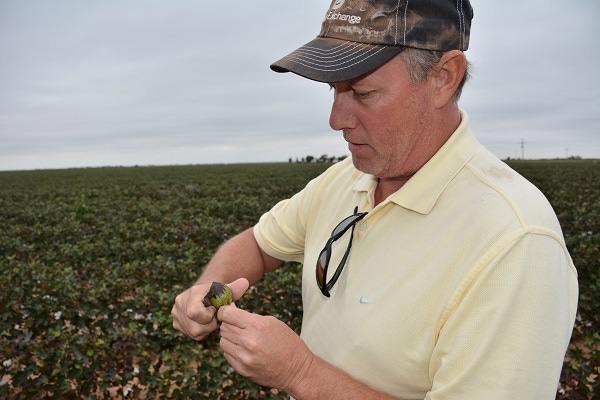
Lubbock County, Texas, cotton and grain farmer Mac Becton plants under just about every water situation imaginable in the High Plains.
Some 35 percent of his irrigated acreage is in subsurface drip; he uses low energy precision application (LEPA) irrigation with some water resources considered light; he still has about 170 acres of row-water irrigation; and he plants dryland.
That much variability requires a bit of scrutiny to determine the best cotton varieties to plant in each of these unique moisture conditions. Long-term drought makes the process even tougher.
“I made no dryland cotton last year,” Becton said following a Bayer CropScience cotton field day near Idalou. “Irrigated cotton was good. A late rain also helped make a grain crop.”
He expects more in 2014. “It looks good,” he said, “if we can get it out of the field and to the gin.”
Rain is the difference. Like most High Plains farmers, Becton started off dry but received some late May rainfall that got the crop started. “We had rain in May, June and July,” he said. “August was mostly dry but we had some rain in late August and then in September.
“September rain was a little late, but it finished off the irrigated fields. It was too late to help dryland cotton.”
He figures rainfall for the year tops 30 inches, more than he received the last three years total.
Good rainfall made everything better this year, but Becton says most years he looks closely at varieties and tries to match performance to water availability.
“I plant several varieties,” he said. “Those include FM 1830 GT and 2989 GLB2. Americot’s NexGen 1511 B2RF is also a good option.”
He likes FM 2011 GT and 2989 on dryland acres. For row water, he usually plants 2989 and FM 1944 GLB2. On light water 1830 is a good choice. “I did some seed blocks with 1830 last year, and it did well on light water irrigation.”
NexGen 1511 performs well on dryland and irrigated fields.
For the latest on southwest agriculture, please check out Southwest Farm Press Daily and receive the latest news right to your inbox.
Planting decisions
Becton attends seed company field days to look at new varieties and to see how those already on the market perform from year to year.
“I talk with other growers to learn what they are planting,” he adds, “and I conduct trials on my own farm to evaluate how varieties do under my conditions. That’s a good way to see how water availability affects performance.”
Becton says farmers need to know more about variety water use efficiency and also about irrigation efficiency and what is considered “good water. That might be 3 gallons a minute. But what is a standard?”
Becton says farmers handle water differently, making establishing a standard for “good water” difficult to determine. “Irrigation system efficiency also varies.”
As he continues to refine his variety selection process, he’s improving water use efficiency. “We currently have 170 acres of row- water irrigation,” he said. “We will take out 60 or 70 of that this fall and put it in drip. We will soon get to zero row-water acres.”
Becton came back to the farm just a few years ago, 2007, after a career in “Corporate America. I got tired of making money for someone else, but I understand the business side of farming,” he said.
“I was also fortunate that my family had been on the cutting edge of drip irrigation installation.”
He’s working 1,200 acres of cotton, corn and grain sorghum. He likes the rotation but says he doesn’t have enough good water to do a fifty-fifty split with grain and cotton every year. “I have about 20 percent of my acreage in grain but even that gives us some options with weed control, which is especially important with herbicide-resistant weeds showing up.
‘We also benefit from organic matter going back into the soil from grain crops.”
Becton would like to see more options for water efficient cotton varieties. “Drought tolerance would help a whole lot in cotton production,” he said. “That would take at least a little risk out of dryland cotton and would give us a chance to make a crop during drought, if hail doesn’t get it.” He thinks drought tolerance is coming. “Seed companies are working toward drought-tolerant cotton varieties. They have it in corn hybrids, and they are working to get it in cotton. The dryland market in this area is big, so it makes sense.”
A declining aquifer makes the effort even more important. “The water situation here is different than it was just five years ago, so we know we need more water efficient varieties.
“We will evaluate where we are every year and look at drip, dryland or laying land out as water declines.”
The declining market, he added, also makes improving production efficiency a necessity. “For now, we have a big price issue.”
With the numerous challenges facing High Plains farmers, including competition for a diminishing water resource, high production costs and inconsistent prices, Becton and others continue to look for more efficient, high yielding varieties, more effective production systems and efficient irrigation to keep their heads above water.
About the Author(s)
You May Also Like






